Robotics & Automation Engineering Journal - Juniper Publishers
Abstract
Reported is a new family of ionic polymer metal composites (IPMCs) actuators, energy harvesters and sensors in slit cylindrical/tubular configurations. The slit IPMC cylindrical/tubular elements are made of bending IPMC slit elements distributed symmetrically around a cylindrical mantle. The slit bending elements around the cylindrical mantle may be either straight and/or parallel with the longitudinal axis of the cylinder for linear actuation and sensing in terms of the length of the entire cylinder or may be helically wound around the cylindrical mantle to produce a combination of linear and torsional actuations and even bending for the slit cylindrical tube. This paper further introduces some models and special cases of linear IPMC actuators and sensors in slit cylindrical/tubular form. Experimental results relating the bending deformation to the axial deformations of slit cylinders are also presented. Of particular interest is the emergence of undulating linear actuation and sensing by slit IPMCs and their combination with twisting and bending to create 3-D soft robotic manipulation and undulation like in an elephant trunk.
Keywords: Novel Configurations; Slit Tubular; Soft Robotic Actuators; Sensors; Ionic Polymer; Metal Composites
Abbrevations: IPMCs: Ionic Polymer Metal Composites; EAPs: Electro Active Polymers
Introduction
Ionic polymer-metal composites (IPMCs) are synthetic nanocomposite materials. They belong to the family of electro active polymers (EAPs). IPMCs deform (actuation mode) in an imposed small electric field (few kV/m). Also, they generate electrical fields (sensing/energy harvesting mode) upon physical deformation or via environmental dynamics, like wind or ocean waves (few mVs for small samples, 10mm x 40mm x 0.2mm). They work both in air and polar liquids such as water and blood. In both cases the conjugated cations need to be mobile enough to migrate towards the cathode when an electric field is imposed on them. This mobility is generally triggered by the osmotic pressure created by the migration of hydrated cations. The mobility and reconfiguration of cations can also be initiated if the IPMCs are in or under water. To maintain consistency in actuation and sensing the IPMCs may be encapsulated with thin silicone rubber sheath, by spraying them with silicone spray to maintain a uniform humidity during actuation, energy harvesting and sensing operations.
An early coverage and review of IPMCs were first published in 1998 by Shahinpoor, Bar-Cohen, Xue, Simpson and Smith [1,2]. However, the original idea of ionic polymer actuators and sensors goes back to 1992-93time frames and the pioneering work of Osada, Oguro, Kawami, Asaka, Takenaka and Shahinpoor [3-14]. IPMCs are composed of an ionic polymer like Nafion® or Flemion® whose surfaces are chemically plated or physically coated with conductors like platinum or gold. The electrodynamics of charge migration and generation in these materials are governed by the Poisson-Nernst-Planck field equations [15-24]. These materials display artificial muscle behavior under an applied voltage or electric field. For example an applied voltages of 1 to 4 volts for a typical sample of the size 10mm x 40mm x 0.2mm typically produces spectacular bending (Figure 1).
Ions migration and redistribution, due to the imposed voltage across a strip of IPMC, result in all kinds of deformations. If the plated electrodes are arranged in a non-symmetric configuration, the imposed voltage can induce many kinds of deformations such as twisting, rolling, turning, twirling, whirling and non-symmetric bending deformation. Alternatively, if such deformations are physically applied to an IPMC strip they generate a voltage signal (few millivolts for typical small samples) as sensors and energy harvesters [25-27].
Figure1a & 1bdepict various deformation configurations of IPMC strips depending on the placement configuration of the electrodes chemically plated on the IPMCs. Such twisting/bending deformations of IPMCs (Figure 1b) may be generated by placing the electrodes on the IPMC strip in eccentric and non-symmetrical configurations. These materials generate a force density of about 40 in a cantilever configuration for sizes around 5mm x 30mm x 0.2mm, meaning they can generate a tip blocking force of almost 40 times their own weight in a cantilever mode[12,23]. In other words if the weight of a cantilever is about 0.06 gmf, based on a density of 2 gm/cm3, the sample can produce a tip blocking force of about 2.4 gmf. Figure 2 displays the actuation and sensing mechanisms in cantilever strips of IPMCs in a graphical manner.

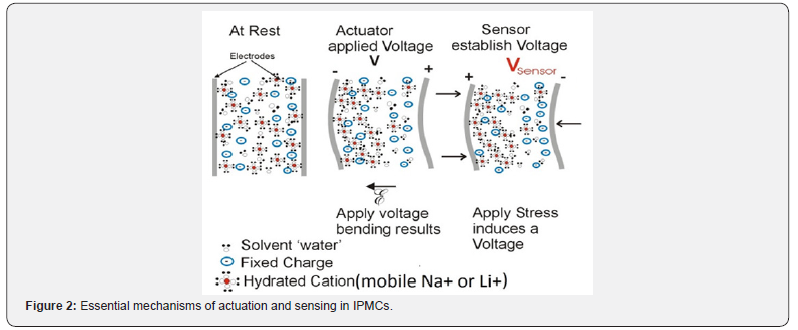
The essential mechanism for both actuation and sensing/ energy harvesting capabilities of IPMCs is the migration of hydrated cations (Na+, Li+), which are loosely adjoined to the underlying molecular network with anions, towards the cathode electrode and away from the anode electrode due to either an imposed electric field (actuation) or an imposed deformation field (sensing/energy harvesting). The cations are generally attached to a number of water molecules (hydration number) which is about 4 for Na+ and 6 for Li+. These deformations are considered to be related to contraction due to depletion of cations from the anode side and osmotic pressure or tension due to arrival of hydrated cations on the cathode electrodes side due to Poisson-Nernst- Planck phenomena [23,24]. It is expected that for a typical sample IPMCs in actuation, sensing and energy harvesting modes there exists a broad bandwidth (kilo HZ and beyond) for their actuation, energy harvesting and sensing response to an imposed electric field or deformation field. The migration of hydrated cations depends on the structure of the base material (DuPont Nafion®, Asahi Glass Flemion®) and how uniform the electrodes are plated on the base material.
In the next section, a brief mathematical model for the actuation and sensing of IPMC is presented.
IPMC Actuation and Sensing Modeling
de Gennes and coworkers [15] presented the first
phenomenological theory for sensing and actuation in ionic
polymer metal composites. Asaka et al. [16] discussed the bending
of polyelectrolyte membrane-platinum composites by electric
stimuli and presented a theory on actuation mechanisms in
IPMC by considering the electro-osmotic drag term in transport
equations. Figure 2 clearly displays the mechanisms of actuation
and sensing of IPMCs. Let us now summarize the underlying principle of the Ionic
polymeric nanocomposites actuation and sensing capabilities,
which can be described by the standard Onsager formulation
using linear irreversible thermodynamics. When static conditions
are imposed, a simple description of mechanoelectric effect is
possible based upon two forms of transport: ion transport (with
a current density, , normal to the material) and solvent transport
(with a flux,Q
, we can assume that this term is water flux). The
conjugate forces include the electric field, and the pressure
gradient  . The resulting equation has the concise form
of
. The resulting equation has the concise form
of

Where,σ and K are the material electric conductance and the Darcy permeability coefficient, respectively. A cross coefficient (Onsager’s coefficient) is usually symmetric or 12 21 L = L = L . The simplicity of the above equations provides a compact view of the underlying principles of actuation, transduction and sensing of the ionic polymer nanocomposites. When we measure the direct effect (actuation mode) we work (ideally) with electrodes which are impermeable to ion species flux, and thus we have = 0. This simplifies the equations to:

This  will, in turn, induce a curvature k
proportional to
will, in turn, induce a curvature k
proportional to  . The relationships between the
curvature k
and pressure gradient
. The relationships between the
curvature k
and pressure gradient  are fully derived
and described in de Gennes, Okumura, Shahinpoor and Kim [15].
are fully derived
and described in de Gennes, Okumura, Shahinpoor and Kim [15].
Note that  is the local induced
bending moment and is a function of the imposed electric field
E, Y is the Young’s modulus (elastic stiffness) of the strip which
is a function of the hydration H of the ionic polymer metal
nanocomposite and I is the moment of inertia of the strip. Note
that locally M(E) is related to the pressure gradient such that in a
simplified scalar format [15]:
is the local induced
bending moment and is a function of the imposed electric field
E, Y is the Young’s modulus (elastic stiffness) of the strip which
is a function of the hydration H of the ionic polymer metal
nanocomposite and I is the moment of inertia of the strip. Note
that locally M(E) is related to the pressure gradient such that in a
simplified scalar format [15]:

Note that vectorially the curvature  is related to the imposed
electric field E
is related to the imposed
electric field E  Based on this simplified
model the tip bending deflection δmax of an IPMC strip of length lg
can be shown to be almost linearly related to the imposed electric
field. The experimental deformation characteristics of IPMCs are
clearly consistent with the above predictions obtained by the
above linear irreversible thermodynamics formulation which
is also consistent with the above equation in the steady state
conditions. Note also that the value of the Onsager coefficient L
has been estimated to be of the order of 10-8m2/V-s [20-24]. Other
parameters have been experimentally measured to be K~10-
18m2/CP, σ ~1A/mV or S/m. On the other hand one may consider
charge transport modeling of actuation and sensing. The reader is
referred to Bahramzadeh and Shahinpoor [20-24] and Shahinpoor
[22-24] for such Poisson-Nernst-Planck equations. Similar to poly (ethylene-co-methacrylic acid) metal composite, member of
the electroactive polymer can be introduced as biomimetic soft
robotic polymer [28-32].
Based on this simplified
model the tip bending deflection δmax of an IPMC strip of length lg
can be shown to be almost linearly related to the imposed electric
field. The experimental deformation characteristics of IPMCs are
clearly consistent with the above predictions obtained by the
above linear irreversible thermodynamics formulation which
is also consistent with the above equation in the steady state
conditions. Note also that the value of the Onsager coefficient L
has been estimated to be of the order of 10-8m2/V-s [20-24]. Other
parameters have been experimentally measured to be K~10-
18m2/CP, σ ~1A/mV or S/m. On the other hand one may consider
charge transport modeling of actuation and sensing. The reader is
referred to Bahramzadeh and Shahinpoor [20-24] and Shahinpoor
[22-24] for such Poisson-Nernst-Planck equations. Similar to poly (ethylene-co-methacrylic acid) metal composite, member of
the electroactive polymer can be introduced as biomimetic soft
robotic polymer [28-32].
Some Experimental Results
Figures 3(a,b&c) represent experimental results for deformation (tip displacement and curvature) of a small strip of slit IPMC (40mm x 12mm x 0.2mm) with simple-supported ends in a small electric field (under 5 Volts/0.2mm) in horizontal and vertical directions. For each graph the bestfittedcurve is constructed to demonstrate the consistency in material response.
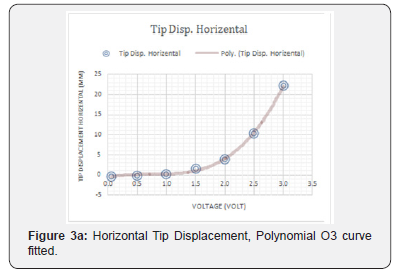
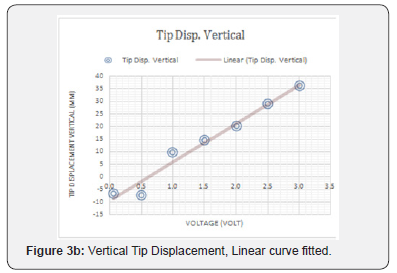
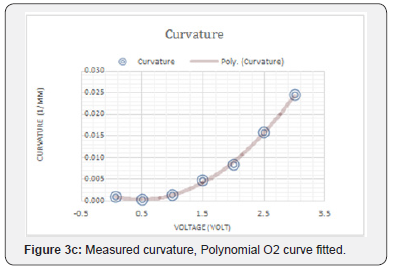
Another set of experimental results were obtained and plotted in connection with slit IPMC strips with built-in ends to recapture the tip displacements in vertical and horizontal configurations, as well as curvature. The results for the second test series are presented in Figure 4(a,b&c).
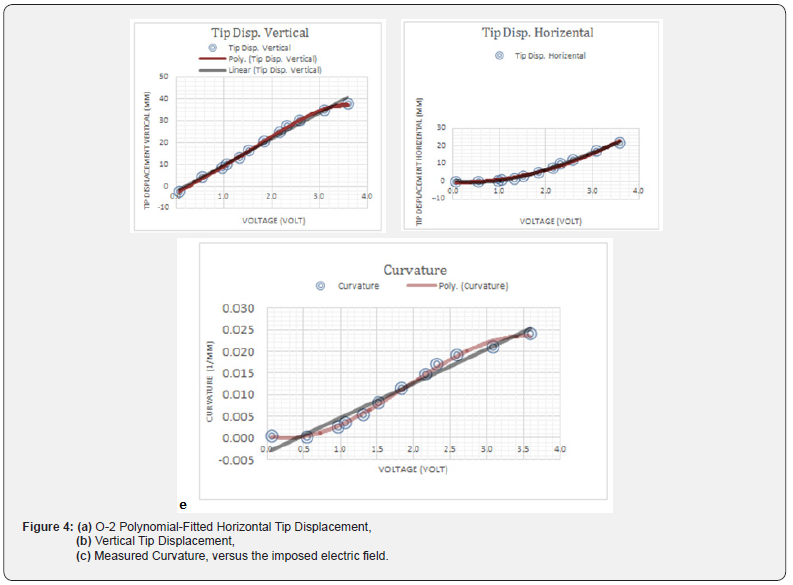
Figure 5(a&b) represents sensing and energy harvesting characteristics of IPMCs [12,23]. Simultaneous actuation and sensing of IPMCs are of interest to soft robotic researchers.

Note that IPMCs havea broad range of applicationsin soft biomimetic robotic actuation, energy harvesting and sensing [23-24]. In this section some novel configurations for IPMC actuators and sensors/energy harvesterswill be introduced. Based on the reported test results in Figure 3&4 for large deformation and actuation of IPMC materials, it is expected these novel configurations will be practically useful for engineering applications.Asimpledescription of actuation in this type of material is based on cationic migration towards the cathode to expand the cathode side of IPMC by osmotic pressure and contract the anode side of the IPMC resulting in bending towards the anode side as depicted in Figure 2.
In other cases and configurations, the IPMC sample can be considered as a non-slit cylinder/tube such that it can act like a linear actuator and generate an axial force (Figure 6).
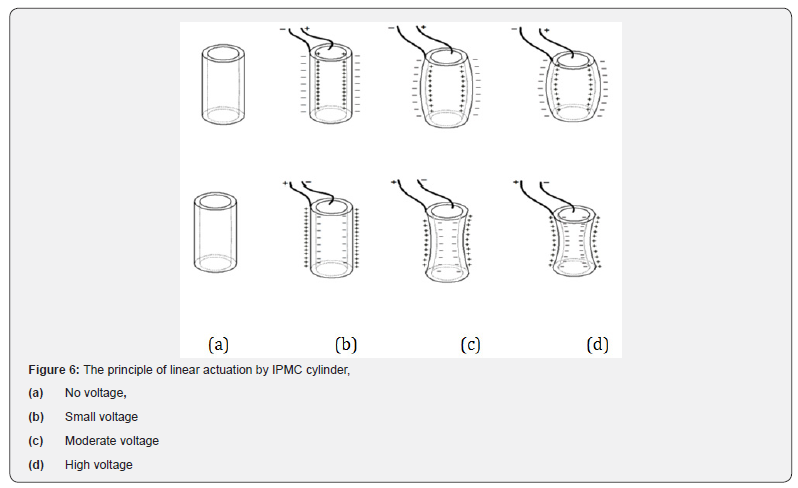
In the sensing mode, the axial forces on both ends force the cylinder to shrink and thus, as a result, the material will accommodate the deformation. This accommodation can be inward or outward. The pressure gradient due to this accommodation will generate the expected signal to sense the displacement [12]. Regarding the buckling instability under axial loading, the non-slit cylindrical/tubular structures will have initial slight curvature outward or inward to minimize buckling instabilities. In addition, from actuation point of view, an applied electric field causes the non-slit cylinder/tube to contract/expand axially/laterally as shown in Figure 6, based on the voltage polarity. This applied field will gradually deform the cylinder to become more like a sphere (Figure 6d).

Another case will be using IPMC strips around a cylindrical/ tubular object or a slit tubular IPMC. Some of the configurations of slit IPMC strips around a cylindrical/tubular mantle are shown below in Figure 7(a,b&c).
In the slit tubular configurations in Figure 7, slit IPMC cylindrical strips experience two major forms of boundary condition for this type of the actuator/sensor family (Hinged in Figure 8a and clamped in Figure 7(b&c). Other form of boundary condition will provide more complex manipulation and maneuver possibilities that will be discussed later. These concept also are likely to be used for applications in pumps/micro-pumps in which the pushing or taking in a fluid can be performed by bending/ deformation of the slit strips in which an inner housing should accompany the assembly. In other word the volume change due to the movement of the IPMCs will initiate the pumping action.
Regarding the sensing mode, whenfor the slit IPMC strips are in a hinge-hinge or simply-supported configuration, there will be less force requirement for the desired displacement andit further results in generatinghigher output voltage. Further, during sensing action the effective length of the IPMC strip is longer. Figure 8, demonstrate the curvature variations related to this formation such that the red regions are in compression and green regions are in tension and the green parts are almost straight.
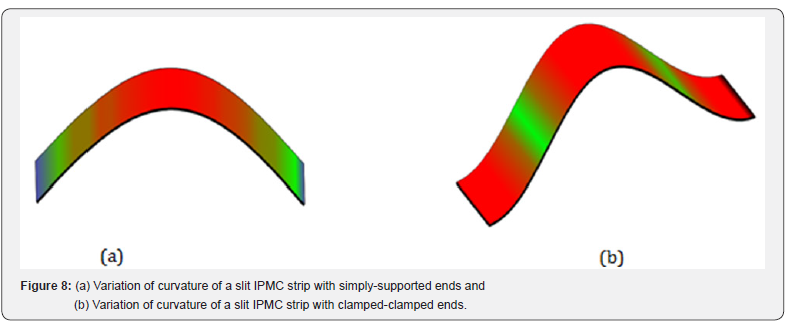
It is also reasonable to note that due to having longer effective length, the hinged-hinged model will have a larger force capacity in actuation. The model with clamped ending will have a shorter effective length to generate output signal and requires a higher level of voltage to operate.
Figure 9 depict a simple form of slit IPMC cylinders in straight simple pinned ending format (Figure 10).
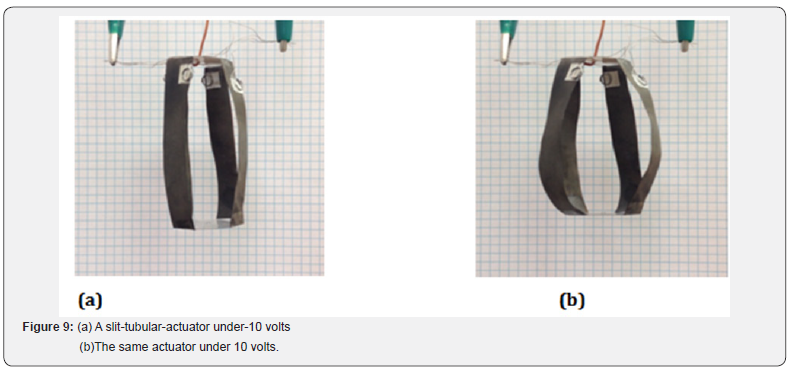
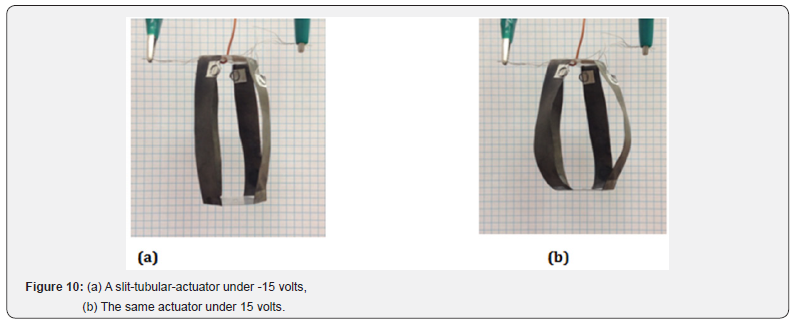
Some variations of these slit cylindrical configurations have been introduced previously by Yeom and Oh [30], Kamamichi [31] and Shahinpoor [23,24] in connection with jellyfish swimming and multi-fingered soft robotic grippers, Figure 11.
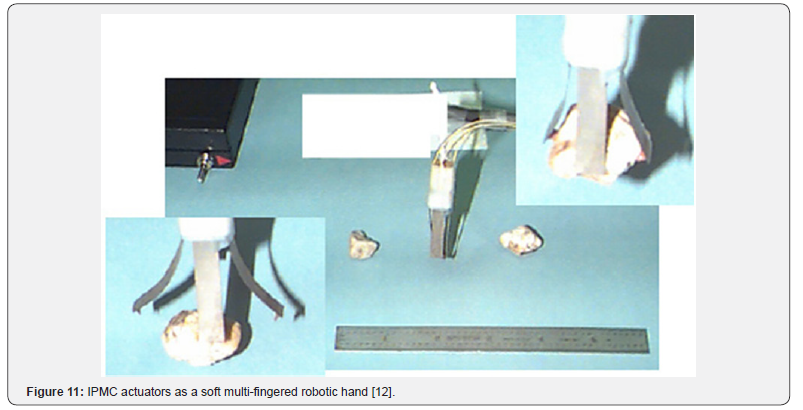

In case of attaching the platform to an arm, these legs can act like multi-fingered soft biomimetic robotic grippers to grasp and manipulate objects.Other configurationswere also discussed by Shahinpoor and Kwang [13], as shown in Figure12
The hinged-hinged configuration will help this possibility in a more efficient way to have longer actuation range.The bending for sensing is generally outward rather than inward because the slit IPMC strips considered are initially slightly bent outward to prevent any buckling instability.
From another point of views, slits on cylindrical configuration can be at an angle to introduce the helically twist and sloped version of helical form of IPMC shown in Figures 13(a&b). This configuration of helically slit IPMC strips will generate axial and twisting motion upon actuation and yet it produces electricity once axially squeezed. Here since the twisting and retracting are related to each other, the model is considered to be more like an actuator.
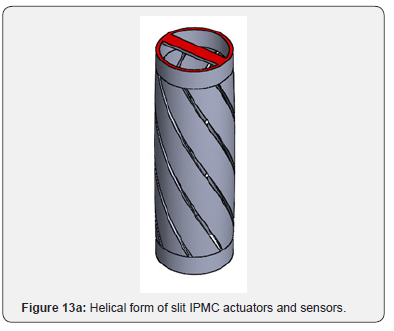
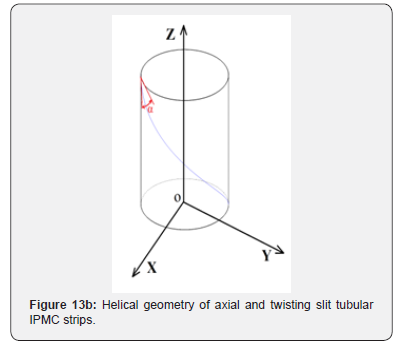
These configurations of slit IPMC strips produces twisting and
linearly moving actuators similar to an automated drill/screw
driver. Note that the helical IPMC actuator/sensor slit strips are like
space curves with coordinates x, y and z such that x = r cosϕ y = r sinϕ and z = c ϕ for ϕ[0,2π] 2π ]where r is the radius of
the helix and c is a constant giving the vertical separation of the
helix’s loops and ϕ is an independent parameter. The tan α= c/r
is slop of the strip sample. The curvature of the helix is given by  torsion
of a helix is given by
torsion
of a helix is given by 
Some studies and modeling for the types of combined linear/ twisting actuators reported in this paper have been proposed by Li and Kim [32] and Moeinkhah and Rezaeepazhand [33] and others. Figure 14(a, b&c) depictvarious configurations of helical assembly of slit tubular IPMCs for actuation, energy harvesting and sensing with more geometric complexitiesare currently under investigations and will be reported later
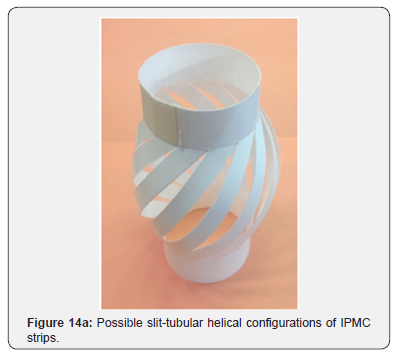
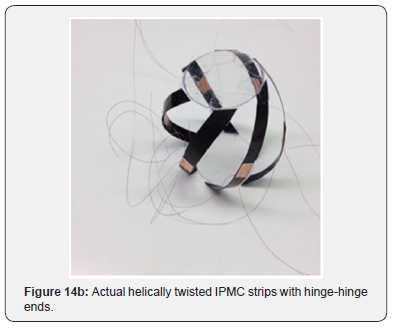
Soft Robotics Snake-Like Configurations Based on Linear-Torsional IPMC Actuators/sensors
Here the initial form of the device considered for the tubularactuators/sensors is a combination of axial and rotary movements that resembles slithering snakes,as shown in Figure 15 below:
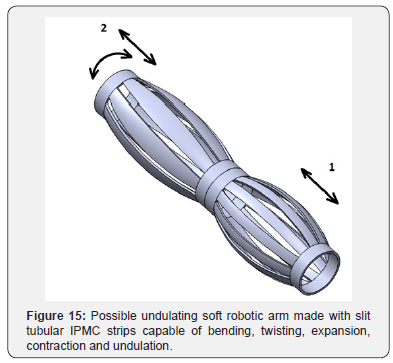
In Figure 15 note that by a combination of movements 1 and 2, the device is capable of 3-D undulating anobject like an elephant trunk or a slithering snake-like flexible robotic manipulator [30]. Referring to Figure 16, in case of having more combination of these actuations configuration, possibility of having a more complex robot can be expected as it is depicted in Figure 16
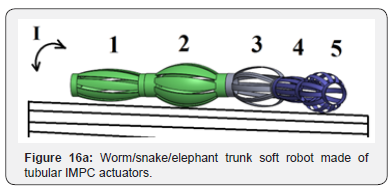
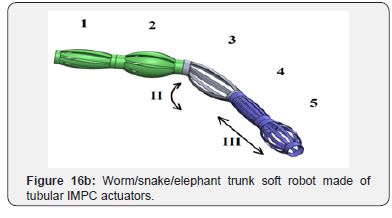
In Figure16 (a&b) a variety of control and boundary condition can be applied to the assembly to move the soft snake-like, wormlike or elephant trunk-like soft robots. For the rotary movement in the direction denoted by I, actuators 1 and 2 are helically arrangedand can produce a combined rotation and slithering movement. The actuator number 3 in Figure 16b enables bending and twisting due to having unsymmetrically applied voltages to generatehelical and planar movements in the direction denoted by II. Yet extensional movements can be achieved by actuator 3 in Figure 16b in the direction denoted by III. Thus, we conclude that combination of cylindrically and helically arranged IPMC actuators are capable of generating elephant-trunk like motion.
Conclusion
A new family of IPMC linear actuators and sensors in the form of a slit tubular structure was introduced and discussed. These groups of actuator and sensors were considered to be made with bending/twisting slitIPMC elements symmetrically distributed around a cylindrical/tubular mantle. These types of soft actuators and sensors are capable of generating a combination of actuation, energy harvesting and sensing consisting of linear expansion, contraction, bending, twisting and rotating action similar to a slithering snake or an elephant trunk.Theslit bending elements around the tubular mantle were designed to be straight and parallel with the longitudinal axis of the cylinder for pure linear actuation and sensing in terms of the length of the entire cylinder. However, the possibility of helically winding the bending elements around the cylindrical mantle to produce a combination of linear and torsional actuation and bending for the cylinder was also briefly discussed. This introduction of linear/torsional actuation/energy harvesting and sensing opens the possibility for introducing new family of soft biomimetic robotic actuators and sensors. The next steps in development of advanced elephant-trunk-like soft biomimetic robotic actuators and sensors are to further explore various cylindrically and helically arranged IPMC strips. Currently, we are further exploring such possibilities towards fabrication an elephant-trunk type soft robot.
To Know more about Robotics & Automation Engineering Journal
Click here: https://juniperpublishers.com/index.php





No comments:
Post a Comment